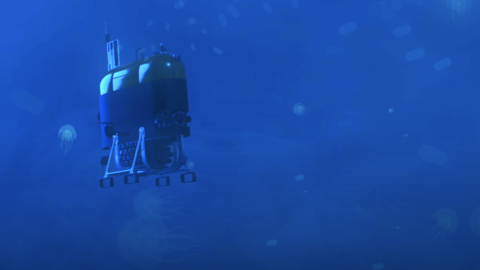From Ship to Shore: Processing Geological Samples
Most deep-sea locations explored by E/V Nautilus are unlikely to be revisited, making the value of the data and specimens collected there priceless to the scientific community. For decades to come, our samples may be the only known information about a particular area and play a vital role in helping researchers around the world understand the geological processes that take place below the ocean’s surface.
ROV Hercules is capable of two methods when collecting geological samples: the push core and the manipulator arm. As its name suggests, the core is a clear tube pushed down into the sediment using the manipulator arm on Hercules where it is then filled and carefully extracted. This method allows the horizontal layers of sediment and any associated microbes to be preserved in a cross-sectional core of that sediment profile, allowing researchers to study the interface between the seawater and the seafloor.
For medium to large rocks, a basic grab with the manipulator arm is usually the most effective. However, it’s not always as easy as it sounds – sometimes a small rock that appeared to be sitting on the surface of the sediment turns out to be massive and extends far below the seafloor! When rocks are “glued” together with a manganese coating, which is common in the deep sea, a crowbar or prying rod may be used to loosen or break off a rock sample. Our team will also use a scoop to collect sediment when maintaining sediment layers is not important or use the slurp hose when collecting rubble.
Once a dive is completed, Hercules returns to the ship for recovery. The science team collects all samples stored in sampling boxes located on the ROV to process them in the wet lab. Attention to detail is crucial during sample processing to ensure that our labeling captures and reflects the important details regarding the environment in which the sample came from and the conditions associated with it.
Once an expedition ends, collected data and specimens live on in the laboratories of researchers, the archives of data centers, and the repositories of institutions for the use of scientists around the world. All geological samples are sent to a repository at the Marine Geological Samples Laboratory (MGSL) at the University of Rhode Island where samples are processed a second time before being stored in the institution’s extensive collection of over 10,000 individual samples. To share information about initial results, Ocean Exploration Trust works with expedition teams to write summaries that are published annually in the Oceanography Society Magazine supplement: New Frontiers in Ocean Exploration.



